By going through these CBSE Class 11 Accountancy Notes Chapter 14 Structuring Database for Accounting, students can recall all the concepts quickly.
Structuring Database for Accounting Notes Class 11 Accountancy Chapter 14
As we know that the working and success of any business is based on lots of information. Every business enterprise needs ready answers to lots of its queries. For this, it requires a proper system that readily provides an accurate and prompt answer to its queries. Numerous techniques and devices have been developed to manage and organize the information.
Before the development of computers, people used to store and process data with the help of papers, file folders, etc. Now-a- days, computers are playing a significant role in performing these tasks. They have replaced all old techniques. The advantages of the computer over the other tools are that it is faster, more accurate, and more reliable than other methods.
In today’s information society, it is often said that information is power. Due to the rapid growth of information technology, all organizations have realized the value of information as a resource.
As we know that computerized accounting involves identifying, storing, and retrieving the data content of transactions. This requires a technique to record and store data in such a way that it allows Its user, easy and convenient retrieval as and when required. This can be achieved by designing a suitable database for accounting. Such a database consists of inter-related data tables that are structured in a manner that ensures data consistency and integrity,
Data can be anything such as a number, a person’s name, images, sounds, etc. So, it is a set of isolated and unrelated raw facts, N represented by values, which have little or no meaning. They have little or no meaning because they lack a context for evaluation. When data is processed and converted into a meaningful and useful form, it is known as information. It is a set of organized and validated collections of data.
Database: Database is a collection of related data. A database is an integrated and logical collection of data. Data is collected and stored in such a way that a common and controlled approach is sufficient in adding new data and modifying and retrieving existing data within the database. A database system is an integrated collection of related files along with details of the interpretation of the data contained therein.
Basic Concept; of Database System of Accounting: Data Processing Cycle Data processing involves the technique of collecting, sorting, relating, interpreting, and computing data items in such a manner as to provide meaningful and useful information for decision making. Data capturing, inputting, processing, and generating information available to the user are the basic steps of the data processing cycle.
In the context of accounting, the data process cycle involves the following steps:
- Source documents
- Input of data
- Data storage
- Manipulation of data
- Output of data
Designing Database for Accounting:
A definite data structure for storing the accounting data is required by both computerized and computer-based A.I.S.
Process of Database Designing:
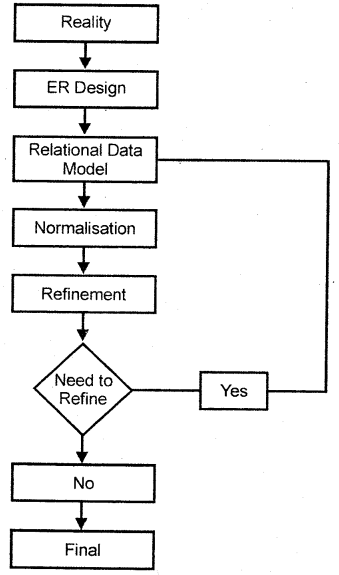
Entity-Relationship (ER) Model:
It is a popular conceptual data model, which is mostly used in database-oriented applications. Even though ER model describes the physical database model, it is more useful in the design and communication of the logical data model.
The model is best depicted with the help of ER symbols. While preparing ER diagram, the following symbols are used to represent the different types of entities, attributes, identifies and relationships:
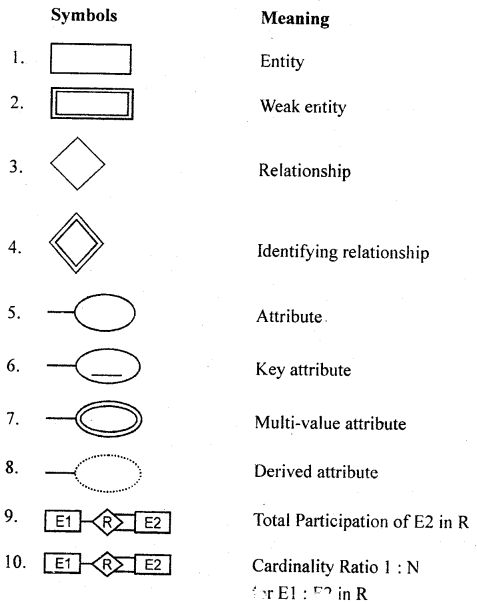
Anything in a real-world with independent existence is called an entity. Accounting data is captured through entities. Some properties of interest that describe the entity are called attributes.
Types of Attributes:
- Composite and simple attributes
- Single-valued and multivalued attributes
- Stored and derived attributes
- Null value
- Complex attributes
- Entity types and entity sets
- Value sets of attributes
Almost every entity type has one of its attributes, which contains unique values for identifying the entity instance. Relationship among two or more entity types represents an interaction among their respective entities. Entity types, which do not has key attributes of their own are known as weak entity types.
ER Presentation of Accounting Reality
1. Accounting database

2. An entity type accounting database

3. An entity type ‘voucher’ with Vno. as a key attribute
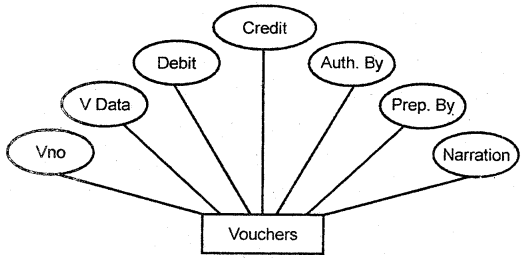
4. An entity type accounts type
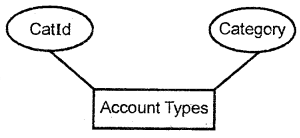
5. An entity type support

Database Technology:
Database Technology is the technique used for designing a database. Concepts that are crucial to the creation of structure and development of the database designs are:
- Reality
- Data
- Database
- Information
- DBMS
- Database System
Reality is some aspect of the real world. It consists of an organization, people facilities, etc., and the environment in which the organization exists arid operates. The continuous interaction with the environment in which it works results in real-world transactions.
Data are known facts that ora be recorded and which have implicit meaning. It represents concerning people, places, objects, entities, events, concepts, etc., it may be quantitative and qualitative or they may be of financial character or Nora-financial character.
A database is a collection of related data. It Is a shared collection of interrelated -data tables, files, or structures, which are designed to meet the varied information needs of an organization.
It has two properties:
- it is Integrated,
- It Is Shared.
An accounting database is a collection of related accounting data to -represent some -aspect of accounting information in a system.
The raw data processed In accordance with decision usefulness becomes information, Information is a date that has -been processed arad refilled, and then presented in a format for decision making purpose.
![]()
DBMS i.e., Database Management System is essentially a collection of Interrelated data, and a set of programs to access this data. This collection of data is usually called the database. It can be regarded as an electronic filing cabinet Database systems are designed to maintain large volumes of data.
Management of data involves:
- Defining the structures for the storage of data.
- Providing fie mechanisms for the manipulation of data.
- Providing for fie security of the data against unauthorized access.
The DBMS is a general-purpose software system that facilitates the process of defining, constructing, and maintaining databases for various applications. A database management system is a collection of programs that enables the user to create and maintain a database.
Defining a database involves specifying the data types, structures, and constraints or the data to be stored in a database. Constructing the database is the process of storing the data itself on some storage medium that is controlled by the DBMS. Manipulating a database includes some functions as query tug Ac database to receive specific data, updating the database to retrieve specific data, updating the database to reflect changes in reality, and generating the reports from the data.
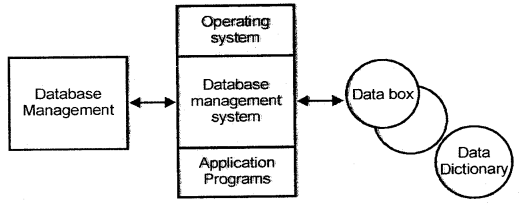
Database Processing for an application
Relational Data Model (RDM):
Relational database stores and organizes information in table rows and columns where rows of a table represent records and columns represent fields. A relational database is one that is built and operated in accordance with the Relational Model of Data proposed by E.F. Codd (1970).
Relational Model provides a simple and intuitive method for defining a database,.storing and updating data in it, and submitting queries of arbitrary complexity to it. It also provides a firm, sound, and consistent foundation for all the other topics that database management systems must commonly embrace, such as security and authorization database integrity, transaction management, reeord&bility and distribution of data.
The relation model is based on the concept of an entity and attribute. An entity is like a name, person, place, or event and an attribute is a property. of an entity. In a relation a table is also called ‘relation’: Each (able is made up of records. Horizontal rows known as records and vertical columns known as attributes.
A domain is a collection of all possible values from which values for a given column or attribute are drawn. The domains are defined for every attribute in the table. The number of attributes determines the degree of the relation. The number of types in a relation is known as the cardinality of the relation. Each table can be identified by a unique name.
Relational Databases and Schemes:
It is a set of related schemes and a set of integrity constraints. A relational database state is a state of relation states such that even/ relational database state satisfies the integrity constraints specified on relational database scheme.
Constraints and Database Schemes
- Domain constraint
- Key constraint
- Entity integrity constraint
- Referential integrity constraint
Operations and Constraint Violations
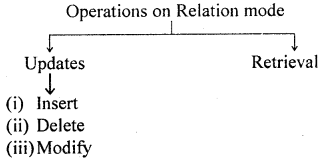
These operations must enforce integrity constraints specified OR relational database schemes. Retrieval operations do not cause violation of any integrity constraints.
Designing Relational Database Scheme
To transform ER design into Relational Data Model design the following steps should be taken:
- Create a relation for every strong entity.
- Create a separate relation for each weak entity type.
- Identify entity types participating in binary 1: N relationship type.
Example: It is based on modified example reality that uses Credit and Debit Vouchers.
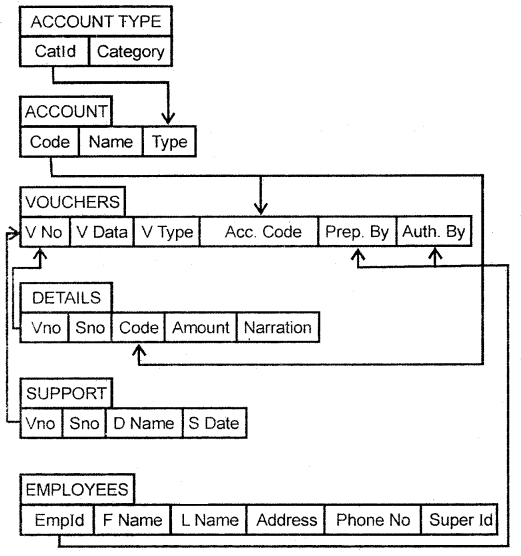
Interacting with Database
Query language enables the users to ask specific questions to the database. Database query languages are not universal such as procedure-oriented languages. Each database may have its own query language with a unique rules instruction format. The most popular query language is a structured query language (SQL), which has an industry-wide standard.
The name SQL stands for Structured Query Languages which was originally called Sequel (Structured English Query Language) developed by IBM in 1970. It has statements for data definition, query, and update. It has the capability to define user-oriented views of the database, specify security and authorization, define integrity constraints, and various other operations. DQL, Data Query Language, is a sub-set of SQL that is widely used. A basic set of queries.
Select-From-Where Structure
- Select: Specify the data or information that is described to answer the query.
- From: Specify the source of data for answering the query.
- Where: Specify the conditions that are used to narrow down the choice of data.